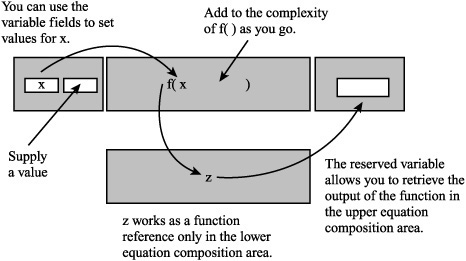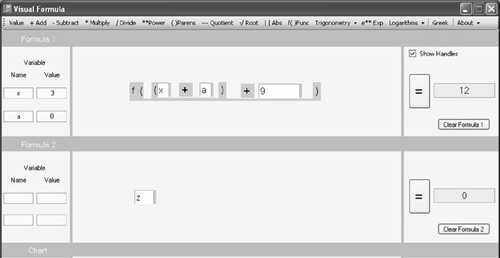Using Visual Formula
Visual Formula allows you to explore relations between domain and range values. The equations you work with as you conduct these explorations can be characterized as functional relations. In subsequent chapters you explore such relations in greater detail. For now, you can use Visual Formula to program variables for fields so that you can explore how equations create domain-range relations.
To set up functions using Visual Formula, you use the f()Func menu item, which generates the f() operator. This operator captures the expression you place between its open and closing parentheses. The output of the operation is stored in a special Visual Formula variable, z. As Figure 4.15 illustrates, the f() operator allows you to operate on values you assign to x. You then access the value of the z variable in the lower equation composition area. When you click the equal sign button in the solution panel of the upper equation composition area, you retrieve the value of z.
Figure 4.15. The z variable allows you to access the output of a function.

Here are a few functions you can set up in the upper equation composition area. Refer to Figure 4.16 as you work. Detailed instructions for setting up the basic function follow.
Figure 4.16. Set up a formula you can alter to accommodate different expressions.

f (x) = 4x + 5 – 2x
a. f (1)
b. f (8 – 3)
c. f (23)
To delete individual operators or fields, hold down the Shift key and click on the operator or field using the left mouse button.
To set up the function in the upper equation composition area illustrated in Figure 4.16, use these steps:
Click the f()Func menu item and position the f() operator in the upper equation composition area. Use the mouse cursor to pull the closing parenthesis to the right.
Click the ()Parens menu item and place a set of parentheses between the parentheses of the function operator. Use the mouse cursor to pull the inner closing parenthesis to the right.
Now successively click the Value menu item three times and with each click place a Value field, as shown in Figure 4.16. You place one just after the opening inner parenthesis. You place a second just before the closing inner parenthesis. You then place a third before the closing outer parenthesis.
To add operators, click the Add menu item twice in succession and with each click place a plus sign in your function. The first plus sign follows the first Value field. The second plus sign follows the closing inner parenthesis.
Having set up the shell of a function, you can now proceed to add constants and variables to it. Toward this end, type x, a, and 9, as shown in Figure 4.16.
To identify and assign values to the variables, in the top Name field of the Variable panel, type x. In the Value field to the right of this field, type 3. Follow up by typing an a in the lower Name field. Type 0 for the value you associate with this field.
Now proceed to the lower equation composition area. Click the Value menu item and place the corresponding field in the lower composition area. Type z in this field. The z variable allows you to capture the output of the function you have created in the upper equation composition area.
Given this work, you can now click the equal sign button in the upper solution panel and see the output of your function. It appears in the upper solution panel answer field. When you add 3 to 0 and then add this sum to 9, the outcome is 12.
Using your work in the preceding steps as a starting point, alter the function so that it accommodates the example functions given in items 1 through 3 preceding the detailed instructions. Change variable values, fields, and operators to accomplish these tasks.
